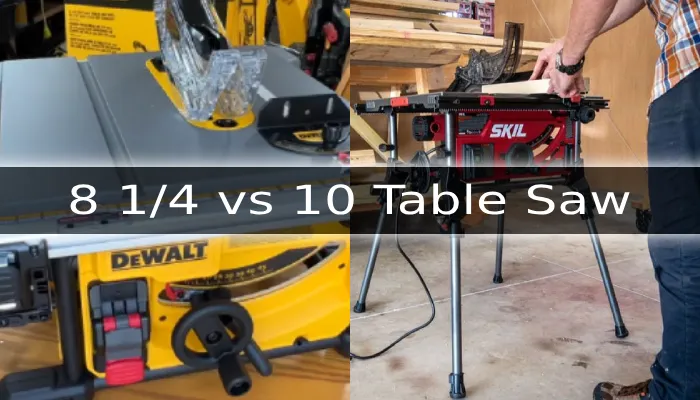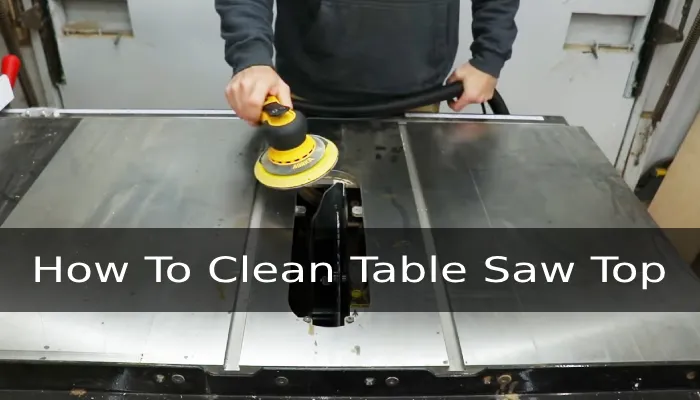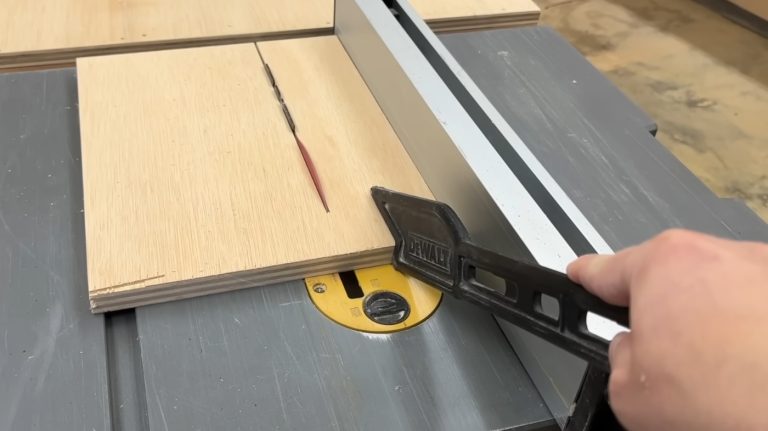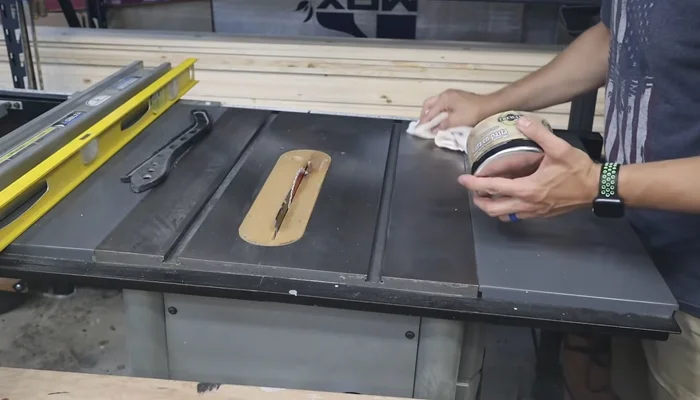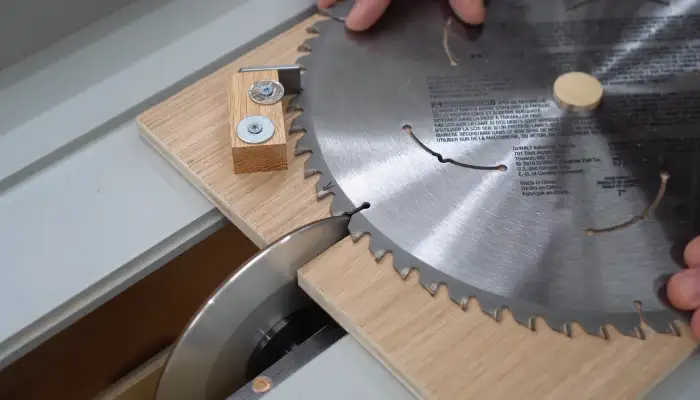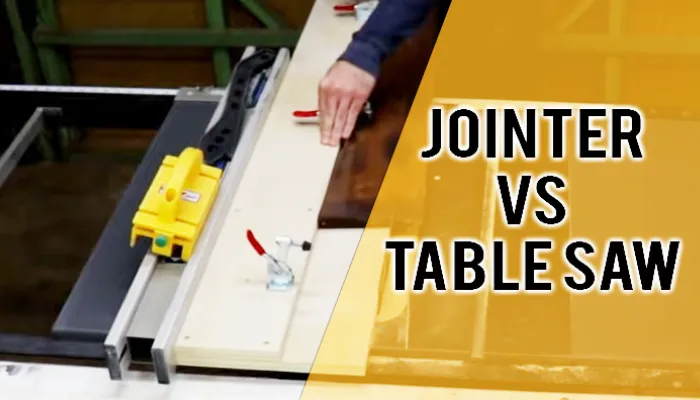8 1/4 vs 10 Table Saw: 12 Major Differences
You’ve decided to take your woodworking skills to the next level and invest in a table saw. Now comes the tough part: choosing between the 8 1/4 and 10 inch options. While both woodworking table saws have advantages, they also have distinct differences that can greatly impact your woodworking experience.
According to my findings, the 10-inch table saw typically boasts a more powerful motor and a larger blade, making it better suited for heavy-duty applications and thicker materials.
In contrast, the 8 1/4-inch table saw, being more compact and lighter, is generally favored for its portability and is ideal for lighter tasks.
So, before you decide, I want to explain the contrasting features of these two popular options, including build quality, power, RPM, motor types, and more. It will help you find the perfect table saw for your woodworking needs.
- Compact Design for Easy Storage
- Rack & Pinion Fence Adjustments
- Professional 24.5″ Rip Capacity
- Site-Pro Modular Guarding System
- Power-Loss Reset Safety Feature
- Powerful 15 Amp Contractor Grade Motor
- Massive 32.5 Inch Rip Capacity
- Durable Rack and Pinion Fence
- Professional Grade 5-Year Warranty
- Portable Design for Job Site
12 Differences Between 8 1/4 and 10 Inch Woodworking Table Saw
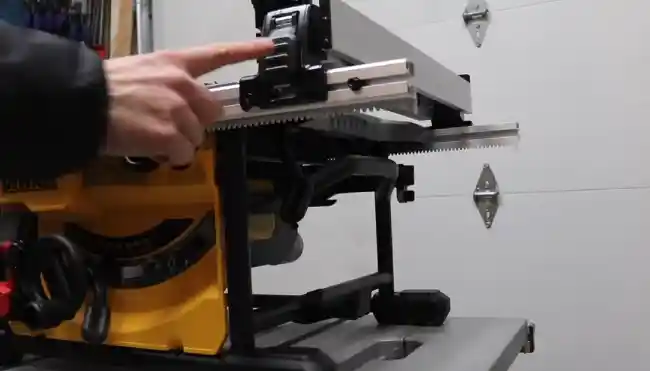
Based on my research, when comparing the differences between an 8 1/4 and 10-inch woodworking table saw, there are several important points to consider.
- Build quality
- Power
- RPM (Rotations per minute)
- Size and portability
- Blade sizes
- Rip capacity
- Rip fence quality
- Safety features
- Dust collection system
- Dado blade compatibility
- Motor types
- Budget considerations
No 01: Build Quality
The build quality of an 8 1/4-inch table saw differs from that of a 10-inch table saw, potentially affecting its durability and performance.
Due to its smaller size, the 8 1/4-inch table saw may exhibit a slightly lighter construction than its 10-inch counterpart. This lighter build can affect the table saw’s overall stability and ability to handle heavy-duty applications.
On the other hand, the 10-inch table saw, with its larger frame, is generally expected to offer a sturdier build, providing better stability during demanding tasks. However, it’s important to note that the build quality can vary among different models within each size category.
No 02: Power
Comparing the power capabilities of an 8 1/4-inch and 10-inch woodworking table saw reveals significant differences in their ability to handle various materials.
The 10-inch table saw generally boasts a higher power rating than the 8 1/4 table saw. This higher power allows the 10-inch saw to tackle more demanding applications that require increased motor power.
Alternatively, the 8 1/4-inch saw, being smaller, may be more suitable for lighter tasks that don’t require as much power. It’s important to consider the power requirements of your woodworking projects when choosing between an 8 1/4-inch and 10-inch table saw.
No 03: RPM (Rotations Per Minute)
The RPM, or rotations per minute, of a table saw blade is an important factor to consider when choosing a saw for your woodworking needs.
An 8 1/4 table saw may have a higher RPM due to its smaller blade size, allowing for faster cutting of materials. This higher RPM translates to a smoother and more efficient cutting experience.
Conversely, a 10-inch table saw with a larger blade may have a slightly lower RPM but compensates with its ability to cut through thicker materials.
No 04: Size and Portability
When considering the size and portability of 8 1/4 and 10-inch woodworking table saws, consider their dimensions and weight to determine their suitability.
The 8 1/4 table saw, being more compact and lightweight, is generally easier to transport and maneuver. This makes it ideal for contractors or DIY enthusiasts who frequently move between job sites. Its smaller size also allows it to fit comfortably in smaller workshops where space is limited.
In contrast, a 10-inch table saw may be bulkier and less portable, but it could provide enhanced stability and support for larger workpieces. This makes the table saw better for professionals working primarily in a fixed workshop and handling larger projects.
No 05: Blade Sizes
With the distinction in blade sizes between the 8 1/4 and 10-inch woodworking table saws, there is a noticeable difference in their cutting capabilities.
An 8 1/4 table saw utilizes a smaller blade, which is advantageous for precision cutting and achieving smoother finishes. The smaller blade size allows for more control and accuracy when making intricate cuts or working with delicate materials.
Conversely, a 10-inch table saw accommodates a larger blade, making it suitable for making deeper cuts and handling thicker materials. The larger blade size enables the saw to cut through dense materials easily, making it ideal for projects requiring a higher cutting capacity.
No 06: Rip Capacity

A woodworking table saw’s rip capacity, or the distance between the blade and the fence, varies between an 8 1/4-inch and a 10-inch model.
The rip capacity is an important factor when choosing a table saw, as it determines the width of the material that can be cut. A 10-inch table saw typically has a larger rip capacity, making it more versatile for cutting wide boards. This allows the user to make long, straight cuts on larger pieces of wood.
Alternatively, an 8 1/4-inch table saw may have a more limited rip capacity, suitable for narrower materials. An 8 1/4-inch table saw may not be able to handle thick or dense materials as efficiently as a 10-inch model.
No 07: Rip Fence Quality
The rip fence is a critical component influencing the accuracy of cuts. A 10-inch table saw often comes equipped with a more robust and precise rip fence, enhancing the saw’s overall cutting performance.
This larger rip fence allows for increased stability and control during cuts, resulting in more accurate and consistent results.
On the other hand, the rip fence on an 8 1/4 table saw may be smaller or less advanced, impacting its ability to maintain consistent and accurate cuts. As a result, the 10-inch table saw may offer a better rip fence quality, ensuring precise and reliable cuts in your woodworking projects.
No 08: Safety Features
Safety features play a crucial role in ensuring the well-being of users when operating woodworking table saws of different sizes. The 8 1/4 and 10-inch table saws are equipped with safety features to protect users during operation.
Nevertheless, the larger size and increased power of the 10-inch table saw may warrant additional safety features. These additional features may include a larger and more robust blade guard, an advanced anti-kickback device, and an enhanced emergency stop button.
On the other hand, the 8 1/4 table saw may have a more streamlined set of safety features but still ensures essential protections. These features may include a standard blade guard, a basic anti-kickback pawl, and a standard emergency stop button.
No 09: Dust Collection System
Dust management is crucial for a safe and productive woodworking experience. The 8 1/4 and 10-inch table saws have dust collection systems to minimize airborne particles. Despite this, the 10-inch table saw typically has a more robust dust collection system due to its larger cutting capacity.
This system is designed to handle a higher volume of debris, ensuring the working area remains clean and dust-free.
On the other hand, the 8 1/4 table saw’s dust collection system may be smaller in scale but still effective for its intended applications. It also allows for easy maintenance and cleaning, keeping your workspace tidy and organized.
No 10: Dado Blade Compatibility

Dado blades, such as grooves or dadoes, are crucial for making wider cuts. However, the compatibility with Dado blades varies between these two table saw sizes.
A 10-inch table saw will more likely accommodate wider dado blades, offering increased versatility for woodworking projects. With a larger blade diameter, it has the potential to handle larger dado blade sets, allowing for the creation of wider grooves.
On the other hand, an 8 1/4 table saw may have limitations on the size of the Dado blades it can use. This may restrict the range of cuts achievable, especially if you require wider grooves or dadoes.
Therefore, if you anticipate working with larger Dado blade sets, a 10-inch table saw might be the most suitable for your woodworking needs.
No 11: Motor Types
10-inch table saws tend to favor more powerful induction motors capable of handling heavy-duty tasks. These motors provide increased torque, enabling the saw to cut through thicker and denser materials with ease.
As an alternative, 8 1/4-inch table saws may incorporate smaller motors suitable for lighter applications. These table saw motors offer sufficient power for cutting through thinner materials, making them more energy-efficient.
No 12: Budget Considerations
Regarding budget, 8 1/4 table saws are generally more affordable than their 10-inch counterparts. This makes them a popular choice for users who’ve cost constraints or are on a tight budget.
On the other hand, 10-inch table saws tend to have a higher price tag due to their larger cutting capacities and additional features. However, it’s important to note that the specific model, brand, and included features can also impact the overall cost within each category.
Comparison Table for 8 1/4 and 10 Table Saw
| Feature | 8 1/4-Inch Table Saw | 10-Inch Table Saw |
| Build Quality | Compact and Lightweight | Sturdy and Durable |
| Power | Suitable for Lighter Tasks | Ideal for Heavy-Duty Projects |
| RPM (Rotations Per Minute) | Higher RPM for Faster Cuts | Slightly Lower RPM, but Adequate |
| Size and Portability | Highly Portable and Maneuverable | Bulkier, Less Portable |
| Blade Sizes | Smaller Blade for Precision | Larger Blade for Depth |
| Rip Capacity | Limited Width Capacity | Larger Width Capacity |
| Rip Fence Quality | Basic Fence Design | Robust and Precise Fence |
| Safety Features | Standard Safety Features | Enhanced Safety Features |
| Dust Collection System | Effective for Lighter Jobs | Robust System for Heavy-Duty Tasks |
| Dado Blade Compatibility | Limited for Narrower Blades | Accommodates Wider Dado Blades |
| Motor Types | Smaller Motor for Light Tasks | Larger, More Powerful Motor |
8 1/4 and 10-Inch Woodworking Table Saws: Choose Your Ideal Option

So there you have the differences between the 8 1/4 and 10-inch woodworking table saws. It’s clear that the 10-inch saw offers a larger cutting capacity and is better suited for heavy-duty projects. However, the 8 1/4-inch saw has its advantages, with its compact size and portability.
In my opinion, it all depends on your requirements and preferences regarding woodworking. If you primarily work on smaller projects or need a more portable option, the 8 1/4-inch saw may be the better choice.
But if you frequently work on larger projects and require a more powerful saw, then investing in a 10-inch model may be worth it. So, choose wisely and let your projects speak for themselves.
- Legendary Worm Drive Gearing
- Precision Rack and Pinion System
- Compact and Lightweight Design
- 2-5/8″ Depth of Cut, 25″ Rip Capacity
- Durable All-Metal Construction
- Legendary Worm Drive Gearing
- Precision Rack and Pinion System
- Compact and Lightweight Design
- 2-5/8″ Depth of Cut, 25″ Rip Capacity
- Durable All-Metal Construction
Last update on 2025-12-26 / Affiliate links / Images from Amazon Product Advertising API

